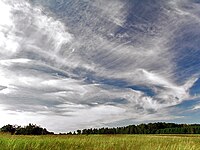
Photo from wikipedia
Abstract We developed an algorithm called Cmask (Cirrus cloud mask) for cirrus cloud detection in Landsat 8 imagery using time series of Cirrus Band (1.36–1.39 μm) observations. For each pixel, a… Click to show full abstract
Abstract We developed an algorithm called Cmask (Cirrus cloud mask) for cirrus cloud detection in Landsat 8 imagery using time series of Cirrus Band (1.36–1.39 μm) observations. For each pixel, a harmonic model, which includes a water vapor regressor, based on all available Cirrus Band observations is estimated using the Robust Iteratively Reweighted Least Squares (RIRLS) regression approach, and pixels affected by cirrus cloud are identified by comparing model predictions and actual satellite observations of the Cirrus Band Top-Of-Atmosphere (TOA) reflectance. Furthermore, we analyzed the effect of increasing Cirrus Band TOA reflectance on the surface reflectance of the Blue, Green, Red, Near Infrared (NIR), and two Shortwave Infrared (SWIR) (SWIR 1 and SWIR 2) Bands based on a set of globally distributed random samples. The goal of this study is to answer the question of what are cirrus clouds in the context of a Landsat observation, or more specifically, when should we identify a pixel as cirrus cloud such that we know the reflectance in the other spectral bands has been seriously affected by cirrus clouds. The challenge is to then develop a simple and operational algorithm for accurate detection of cirrus clouds in Landsat 8 images. The Cmask algorithm reduced almost by half the errors found in the U.S. Geological Survey (USGS) Quality Assessment (QA) Band for distinguishing cirrus cloud and clear observations (8% versus 15% error).
Journal Title: Remote Sensing of Environment
Year Published: 2020
Link to full text (if available)
Share on Social Media: Sign Up to like & get
recommendations!